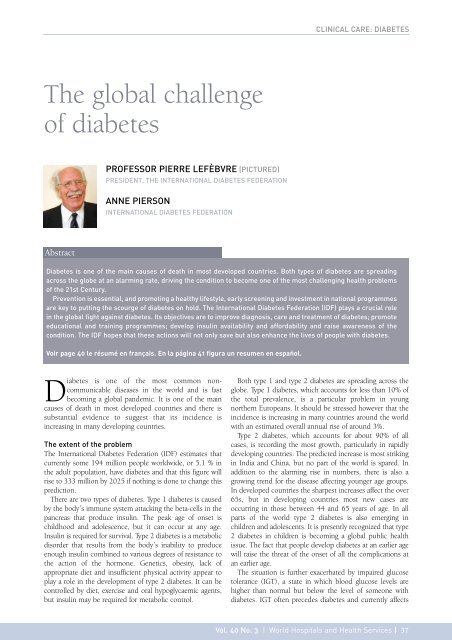World Hospitals and Health Services - International Hospital ...
World Hospitals and Health Services - International Hospital ...
World Hospitals and Health Services - International Hospital ...
Create successful ePaper yourself
Turn your PDF publications into a flip-book with our unique Google optimized e-Paper software.
CLINICAL CARE: DIABETES<br />
The global challenge<br />
of diabetes<br />
PROFESSOR PIERRE LEFÈBVRE (PICTURED)<br />
PRESIDENT, THE INTERNATIONAL DIABETES FEDERATION<br />
ANNE PIERSON<br />
INTERNATIONAL DIABETES FEDERATION<br />
Abstract<br />
Diabetes is one of the main causes of death in most developed countries. Both types of diabetes are spreading<br />
across the globe at an alarming rate, driving the condition to become one of the most challenging health problems<br />
of the 21st Century.<br />
Prevention is essential, <strong>and</strong> promoting a healthy lifestyle, early screening <strong>and</strong> investment in national programmes<br />
are key to putting the scourge of diabetes on hold. The <strong>International</strong> Diabetes Federation (IDF) plays a crucial role<br />
in the global fight against diabetes. Its objectives are to improve diagnosis, care <strong>and</strong> treatment of diabetes; promote<br />
educational <strong>and</strong> training programmes; develop insulin availability <strong>and</strong> affordability <strong>and</strong> raise awareness of the<br />
condition. The IDF hopes that these actions will not only save but also enhance the lives of people with diabetes.<br />
Voir page 40 le résumé en français. En la página 41 figura un resumen en español.<br />
Diabetes is one of the most common noncommunicable<br />
diseases in the world <strong>and</strong> is fast<br />
becoming a global p<strong>and</strong>emic. It is one of the main<br />
causes of death in most developed countries <strong>and</strong> there is<br />
substantial evidence to suggest that its incidence is<br />
increasing in many developing countries.<br />
The extent of the problem<br />
The <strong>International</strong> Diabetes Federation (IDF) estimates that<br />
currently some 194 million people worldwide, or 5.1 % in<br />
the adult population, have diabetes <strong>and</strong> that this figure will<br />
rise to 333 million by 2025 if nothing is done to change this<br />
prediction.<br />
There are two types of diabetes. Type 1 diabetes is caused<br />
by the body’s immune system attacking the beta-cells in the<br />
pancreas that produce insulin. The peak age of onset is<br />
childhood <strong>and</strong> adolescence, but it can occur at any age.<br />
Insulin is required for survival. Type 2 diabetes is a metabolic<br />
disorder that results from the body’s inability to produce<br />
enough insulin combined to various degrees of resistance to<br />
the action of the hormone. Genetics, obesity, lack of<br />
appropriate diet <strong>and</strong> insufficient physical activity appear to<br />
play a role in the development of type 2 diabetes. It can be<br />
controlled by diet, exercise <strong>and</strong> oral hypoglycaemic agents,<br />
but insulin may be required for metabolic control.<br />
Both type 1 <strong>and</strong> type 2 diabetes are spreading across the<br />
globe. Type 1 diabetes, which accounts for less than 10% of<br />
the total prevalence, is a particular problem in young<br />
northern Europeans. It should be stressed however that the<br />
incidence is increasing in many countries around the world<br />
with an estimated overall annual rise of around 3%.<br />
Type 2 diabetes, which accounts for about 90% of all<br />
cases, is recording the most growth, particularly in rapidly<br />
developing countries. The predicted increase is most striking<br />
in India <strong>and</strong> China, but no part of the world is spared. In<br />
addition to the alarming rise in numbers, there is also a<br />
growing trend for the disease affecting younger age groups.<br />
In developed countries the sharpest increases affect the over<br />
65s, but in developing countries most new cases are<br />
occurring in those between 44 <strong>and</strong> 65 years of age. In all<br />
parts of the world type 2 diabetes is also emerging in<br />
children <strong>and</strong> adolescents. It is presently recognized that type<br />
2 diabetes in children is becoming a global public health<br />
issue. The fact that people develop diabetes at an earlier age<br />
will raise the threat of the onset of all the complications at<br />
an earlier age.<br />
The situation is further exacerbated by impaired glucose<br />
tolerance (IGT), a state in which blood glucose levels are<br />
higher than normal but below the level of someone with<br />
diabetes. IGT often precedes diabetes <strong>and</strong> currently affects<br />
Vol. 40 No. 3 | <strong>World</strong> <strong><strong>Hospital</strong>s</strong> <strong>and</strong> <strong>Health</strong> <strong>Services</strong> | 37

















